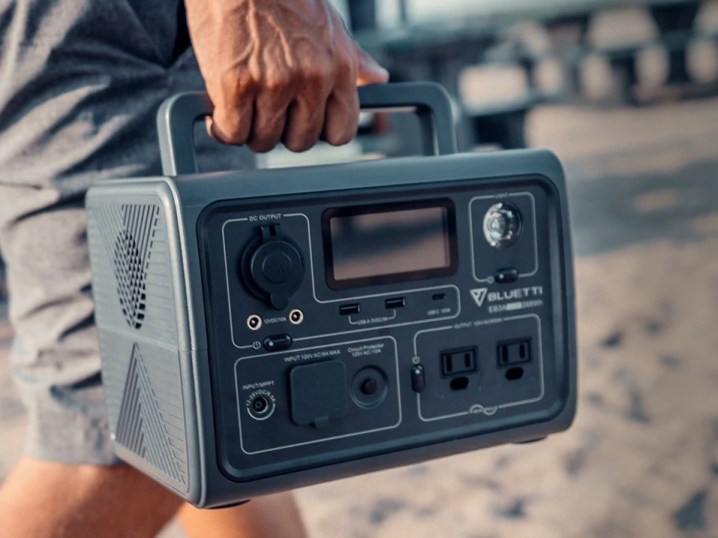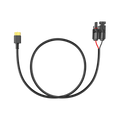Your cart is empty
Shop our productsSolar generators are becoming extremely popular in the United States and throughout the world.
At first, they were seen as more of a convenience item, one that you could bring along on a camping trip to charge your phone or laptop.
Today, as technology gets more advanced, we are seeing improvements in energy storage capacity and use, allowing solar generators to power whole houses in the event of a blackout.
These improvements increase the design complexity, leading consumers to having more questions during the purchasing process.
In this article, we aim to answer those questions and help you understand what to look out for when buying a solar generator.
The different components of a solar generator

A solar generator has 4 major components that allow it to function. Those components are:
- Solar panel
- Battery
- Charge controller
- Inverter
Solar Panel
Most of you are likely already familiar with solar panels. They are the bit of technology that harvests sunlight and turns it from irradiation to electricity. It does this through the process known as the photovoltaic effect.
BLUETTI sells 5 models of solar panels. Those are the PV68, PV120, PV200, PV350 and the PV420.
All these panels use the same technology and are simply categorized by different power ratings.
The higher your solar panels' power rating, the faster it will charge your solar generator.
Battery
Probably the most essential component of a solar generator is its battery. The battery size will determine how long you are able to power appliances for.
Our solar generator batteries are rated in Watt Hours (Wh).
The higher this number, the more energy storage capacity your solar generator will have, and thus the longer it will power your appliances.
Charge controller
The charge controller is responsible for delivering the electricity collected by your solar panels to your battery.
It ensures that your battery is not damaged by getting an overloaded amount of current. It also effectively tells your panels to stop delivering electricity to your battery should it be fully charged.
Charge controllers are automatically sized for each solar generator, so you do not need to worry about this when selecting a solar generator.
Inverter
Perhaps the second most important component of a solar generator is its inverter. Remember, a battery stores DC electricity collected from your solar panels.
However, household appliances require AC electricity in order to function. That is where your invert comes in. Your inverter converts DC electricity to AC.
Inverters come rated in watts. That is, they are only able to power appliances that fall within their power rating. For example, an inverter rated at 500 watts will not be capable of powering a toaster rated at 1500 watts.
What size solar generator will I need?

Now to the fun bit. There is no exact science to sizing your solar generator. It really all comes down to your individual situation. There are, however, some formulas you can use to help you make the right choice.
The method includes outlining the appliances you wish to power and tallying up the combined power draw as well as energy consumption.
Your table should look something like this:
| Appliance | Wattage | Usage | Wh |
| X10 Led Lights | 100 | 2 hours | 200 |
| Television | 70 | 2 | 140 |
| Fridge | 300 | 2 | 600 |
| Electric Cooker | 1500 | 0.5 | 750 |
|
Total
|
1970 W | N/A | 1690 Wh |
So, simply recreate your own table with your own appliances. Include the appliance, and it's wattage. Then jot down how many hours you aim to power that appliance (with your solar generator). Then to calculate the Wh, multiply your wattage by the usage time.
By doing the above, you can tell which solar generator (in terms of battery capacity and inverter wattage) will suit your needs.
In the example above, we will need a 1690 Wh solar generator with a power rating of at least 2000 watts.
However, keep in mind that it is unlikely you will be powering all appliances simultaneously, meaning your required power rating will be dramatically less (in most cases).
However, with the above example, we recommend the AC200P solar generator to be safe.
What technology does it use?
Some other things to pay attention to would be the technology that makes up your solar generator.
For example, what type of battery chemistry does it have, or what kind of inverter does it use, pure sine wave or sine wave, etc.
These are essential factors that will help you decide whether or not this is a worthwhile investment or not.
Battery Chemistry
Ideally, you will want a solar generator that uses Lithium Iron Phosphate (LiFePO4) batteries. These batteries offer the best DoD and allow for the most life cycles. They are also one of the safest battery chemistries on the market. Meaning your Levelized Cost of Storage (LCOS) will be the best.
Inverter type
When it comes to inverters, you are only looking for one type, and that is pure sine wave inverters. Anything other than this is inadequate for solar generators.
Charge controller type
Similar to inverters, you will want a solar generator with a built-in Maximum Power Point Tracking (MPPT) charge controller. Thankfully, most modern solar generators on the market use MPPT charge controllers. Nevertheless, this is something to look out for.
Final Thoughts
With all that being said, one more thing you will want to look out for is the type of solar panel your purchase.
Ideally, make sure it is a monocrystalline solar panel with a high-efficiency percentage.
It should be known that all BLUETTI solar generators come with the top-of-the-line technology listed above.
Shop products from this article
Be the First to Know
You May Also Like

What Does a 30% Federal Solar Tax Credit Mean and How to Apply?
Governments around the world are offering programs that encourage homeowners to switch to solar energy. Among the most notable programs is the 30% Federal Solar Tax Credit. It reduces your...

Deadly Flooding Devastates U.S. South and Midwest — What You Need to Know

















































































































































































































































